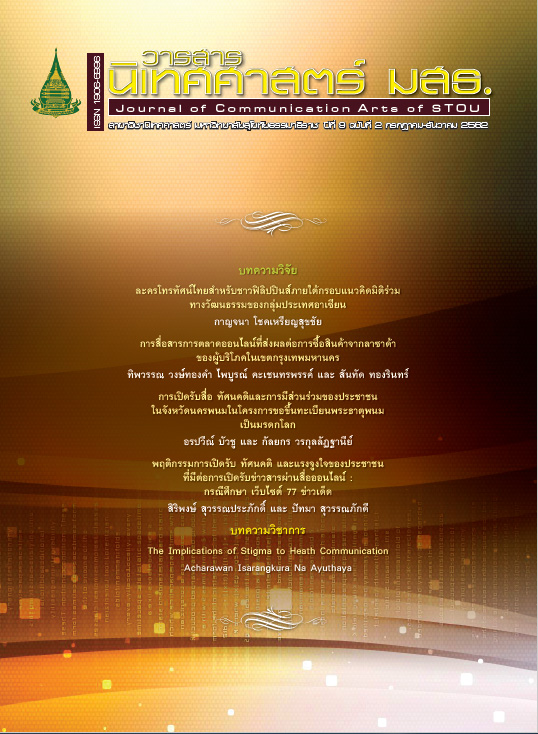The Implications of Stigma to Heath Communication
คำสำคัญ:
Health Communicationบทคัดย่อ
The gravity of stigma had been understated in health communication. However,
healthcare practitioners and researchers have better understood its impacts to both public
health and health communication. This essay summarizes Erving Goffman’s seminal study of
stigma, and the critiques of his work in both the Thai and English literatures. Then the
implications of stigma in health communication are elucidated with a focus on how
HIV/AIDS related stigma strains the world’s fight against HIV/AIDS. Goffman’s stigma
theory is underpinned by the essentialist notion of the sources, and the analytical scope of the
management, which is limited to the stigmatized individuals’ interactions with strangers. To
complement Goffman’s theory, scholars have investigated the interplays between stigma and
the pre-existing socio-cultural factors, such as power relations, gender biases, legal
mechanism and mass media. Almost six decades of stigma studies has illuminated the gravity
of this universal phenomenon and the challenges to health communication. Both the Thai and
international literatures suggest a possibility of collective stigma management.
In 1963, American sociologist Erving Goffman’s Stigma: Notes on the Management of
Spoiled Identity was published to shed light on the implications of stigma in interpersonal
interactions. For six decades after Goffman’s groundbreaking work, the issue of stigma has
been examined by a wide variety of academic disciplines. Goffman predominantly dealt with
stigma management in impersonal contact with strangers, and pay little attention to that in
recurring contacts with familiar persons (Gussow and Tracy, 1968). In addition, Goffman’s
studies say little about the roles of perpetuators in stigma management.
This essay first overviews Goffman’s seminal study of stigma, and examines the critiques
of his work in both the Thai and English language literature. After that, the implications of
stigma vis-à-vis health communication, especially HIV/AIDS related stigmas both in and
outside Thailand, are elucidated.
Health communication practitioners have now understood the gravity of stigma in their
practices. For example, anti-Polio vaccination campaigns have been severely affected in
Muslim societies, such as Northern Nigeria and Pakistan because of the distrust of the
Western aids in Muslim societies. Not only did the stigma stall vaccination campaigns, but
also cost the lives of local health workers and the local populations (Chen, 2004; BBC News
2018).
In Thailand, stigma has also been an obstacle for anti-HIV/AIDS campaigns. ‘AIDS
stigma’ has caused various forms of discrimination, ranging from mockery to violence. It
deprives people living with HIV/AIDS PLWHA of dignity and access to eligible resources
and opportunities that are essential for their survival (Isarangkura Na Ayuthaya, 2006, p. 2-
3). AIDS stigma prevents the patients from seeking timely diagnosis and treatment. The
majority of Thai PLWHAs in fact become aware of their seropositive status only after their
health conditions deteriorate (World Bank, 2000, p. 24-25). Some PLWHA even stop seeking
essential services, such as treatment, counselling, free condoms, or needle exchange. In order
to ensure the success of the anti-HIV/AIDS campaigns, non-discriminatory communication
must be promoted at the different levels of health care. Social and cultural factors, including
stigma, adversely affect the wellbeing of the public even if effective and financially viable
medical treatment or preventative measures is available.





